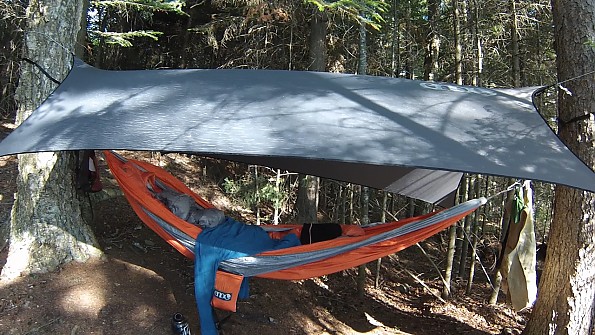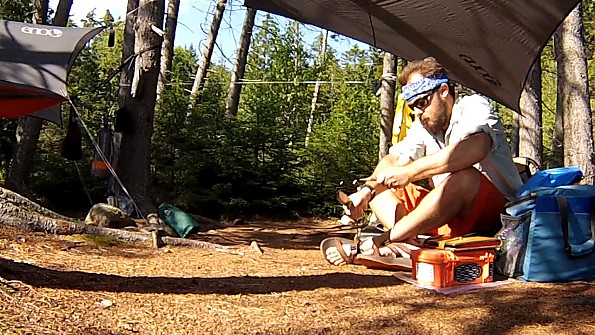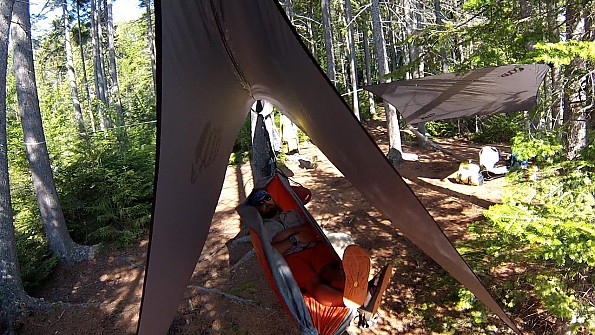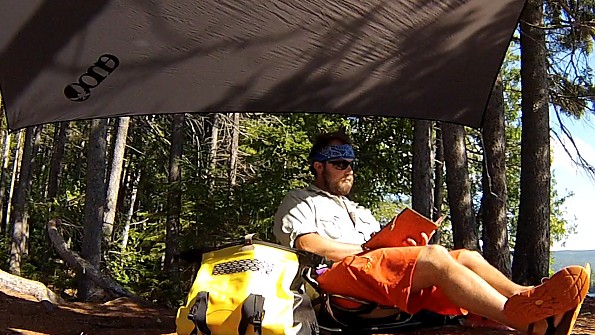Sierra Designs Backcountry Bed 600 / 30 Degree
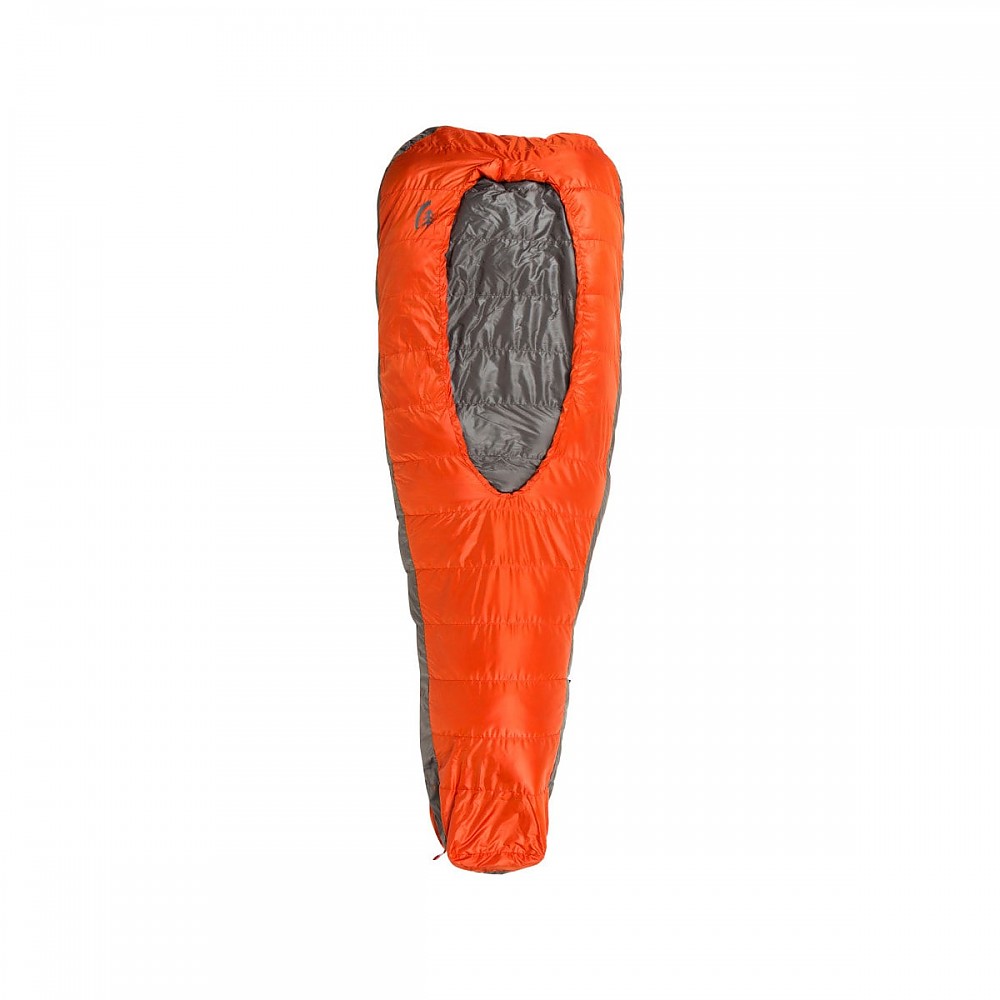
The reinvention of the sleeping bag is upon us! If you hate stuck zippers, if you hate suffocating into the side of your hood, and if you hate rolling off your pad, then you love the Backcountry Bed!!
This bag is for folks who have been overall discouraged by sleeping bag use and wish they had the bed roll of old!
Pros
- More bed, less bag
- Roomy
- No zipper
- Great for side sleepers and hot sleepers
- DriDown!!
Cons
- Not great in a hammock
- Pad can slip out from under feet
The comfort rating for this pad is 27-37 degrees F
Fits user up to six feet
Trail weight is 2lb 8oz
Sleeping pad size is 20"
Fill = 600 Fill Duck Dridown
I used this bag in an ENO DoubleNest hammock with a Klymit X Frame pad in Maine. I was teaching primitive and survival skills via canoe on Lake Mooselookmeguntic.
The bag was plenty warm even though we had some very cool, damp nights, definitely mid 50s or cooler. While the entrance to this bag is more like a fixed quilt than the standard side entry zipper, making thermoregulation easier to attain and control, getting into and out of the bag while in a hammock was less than desirable.
One is forced to enter the hammock from way above the head, slide feet first past the sewn comforter, and then slide to the foot of the bag while centering one's self in the hammock. However, everything that makes this bag less than ideal for hammock use, makes it absolutely wonderful for bivy and tent use!
DriDown is no joke. It is not a gimmick. The idea of waterproofing/resisting down really works! I have been using DownTek and DriDown in various bags and layers since their conception. This is an exceptional Dridown piece.
The air in my camp, lakeside, Toothaker Island, was extremely humid in the early mornings. (I could probably have had my fly a little lower to catch the dew, but alas, I did not. This means the dew was all over my bag every morning.) I never laid the bag in the sun to dry. I figured proper testing would require thorough testing of the DriDown's ability to get moist, and then dry without the sun's help.
It dried alright! In the North Country of New Hampshire, all of New England for that matter, and of course 44 degrees North Latitude and up the world over, most items that get wet, stay wet. If it is storming up here, it stays storming or at least threatening, for the extent of most adventures it seems. In the North Country DriDown and DownTek are imperative!
The bag offered good loft. Being a summer/2 season bag, I expected very little, but appreciated what I got. The bag was very packable. It lived in a 20 liter dry compression sack with my Klymit pad, all my clothes, and a towel with plenty of room to spare.
The sleeping pad integrates with the bag via a pocket, or short sleeve, coming from the head down to about the mid back. There is no pad sleeve for the feet. I wiggle and turn quite often during my slumber, some way to fix the pad to the feet would have been appreciated. However, the bag is designed for maximum versatility for every kind of sleeper, in a tent, the lack of pad fixture to the feet would actually be appreciated.
During a three-night pack in, base camp, and paddle out, the bag seemed plenty durable. I loved that the inside is so silky, yet pine needles didn't stick to it as they would a sleeping bag liner (my sleep system during this trip last year).
There is also a nifty foot vent at the bottom. If one pulls their feet up and then down a sort of channel between the inner insulation and the outer, it is very easy to vent the feet as one may choose to do by zipping a traditional sleeping bag's zipper up from the bottom. As I got chilled upon leaving the communal fire, but then warmed back up in the Backcountry Bed, the option for venting was highly appreciated.
I will buy one of these bags for trips when I am using a tent or hiking from shelter to shelter. I do not know how I would feel about it for three seasons, but as a summer bag, I love it!! I will have to try the three season Backcountry Bed next.
Source: borrowed it
Innovative design with no zippers and built-in comforter. Warm below rating for me who usually sleeps cold. Fairly compressible. DriDown works well. Pad stays put in sleeve for good night's sleep.
Pros
- Versatile across a range of temperatures
- DriDown works well
- Good for side and stomach sleepers
Cons
- A little hard to get into and out of at first
- On the heavy side (not ultra light)
The Backcountry Bed is, as most of you must have heard by now, a new kind of sleep system. It does indeed have the qualities of your bed at home although it is a little harder to get into and out of. I have been using my Backcounty Bed in my yurt at home all winter and have just taken it out into the field on a four-night river trip in Utah and Colorado below Flaming Gorge on the Green River.
It was a very wet trip and the DriDown really worked. The first night all our tents were filled with condensation and my bag got soaked. It didn't seem to affect the performance of the down much. Temperatures were in the high to low thirties the entire trip at night (lower than the rated temps for this bag) and I slept warm which is unusual for me. I wore a lightweight SmartWool top and boot cut Patagonia R1 underwear and was very comfortable.
I have used synthetic bags on almost all of my river excursions because they are supposed to perform better when wet and camping beside a river is usually somewhat damp. I was a little nervous taking a down bag but decided to chance it because the Backcountry Bed is so comfortable.
I needn't have worried. I used a Therm-a-Rest RidgeRest pad in the sleeve, which is what I intend to use when I backpack with this bag. The RidgeRest provided enough structure and warmth. The upper section of the back of the Backcountry Bed is not filled with down to save weight and the down would compress anyway and not provide much warmth.
I was warm and I just don't like bouncing on inflatable pads nor do I like the self inflating foam pads. This of course is personal preference and the sleeve would accommodate either. I like to feel the ground when I am sleeping on it. Weird, I know.
Getting in and out of the bag is a little tricky at first. The opening is a little far up the bag so there is some contortion the first few times in a tent but once you get the hang of it it is not particularly bothersome. I like being able to move around inside the bag and not get all twisted up. The pad helps the bag hold its shape while you move around inside the bag.I usually go to sleep on my side and then end up on my stomach and this is what I did in the bag.
The best part of the bag was how it adapts to temperature changes in the night. I was too warm at first and pulled the comforter out of the top of the bag to let cool air in, later in the night as the temperature fell, I it tucked the comforter inside the opening effectively sealing out all cold air. One night I even put my head inside the top of the bag opening for added warmth.
This really is a versatile bag. I was worried that it might not seal out the cold air but I had no problems. At one point I even stuck my feet out the opening in the leg section of the bag to get a little more circulation. Sierra Designs really put some thought into this bag's design.
I can' t wait to take this bag out on the trail. It is about 2 lbs. which isn't ultralight but it is versatile so I can deal with a few more ounces. All in all I am very happy with this bag.
Source: bought it new
Price Paid: $259
This bag is the perfect combination between a sleeping bag and a backpacking quilt. It allows you to sleep on your back, side, or stomach with ease. If you are a hot sleeper you can simply pull the attached top quilt away from your body allowing your top half to be exposed while your lower extremities are inside the bag.
The Dridown fill makes worrying about the elements a no nevermind and its construction seems to be durable and will last me for years to come.
Pros
- Adaptability to numerous sleeping styles
- Weight
- Filler material
- Cost
- Sleeping pad sleeve integrated
Cons
- None
I took this out for an overnighter in the Appalachian Mountains this past summer. The temperature dropped to sub 40˚ F and this bag did not fail to perform. My wife woke me up in the middle of the night shivering cold, so I told her to get in my bag and I would take hers, which was rated around 45˚ F. Within a few minutes she was snoring so loud I was unable to sleep.
I will look into purchasing another of these bags for my wife as she explained to me in the morning that this was one of the best night’s sleep she has had in the backcountry. I told her "Yeah, my sleep was pretty good too until someone stole my sleeping bag."
The bag stuffed right into the bottom of my pack with no issues and within 5 minutes we were packed up and ready to roll out. Sierra Designs hit the nail on the head with this design and I will definitely be getting one of these for my wife.
Source: bought it new
Price Paid: $199
I'm a believer. Took the leap and bought a Sierra Design Backcountry Bed. Zipper-less, roomy, down warm weather sleeping bag. Great bag for side sleepers and those move around a lot at night like me.
I find the bag works best for warmer weather nights (over 40 degrees). Great for base camps, car camping, and shorter backing trips. There are lighter bags but at an increased cost. I would buy a SD Backcountry Bed again.
Pros
- Comfort
- No zippers
- Roomy
- Top quilt
- Cost
Cons
- Weight for temperature rating
I haven't found a more comfortable down bag yet. I love not having a zipper. No stuck, snagged zippers, no difficult exits at night when nature calls. This bag is roomy. Perfect for a side sleeper that likes to roll around.
I ordered the long version as I am 6'4" and it fits perfectly.
Don't push the EN comfort rating of 37 degrees. Anything below 45 and I recommend additional insulation. Only once did I get cold when the temperature dropped expectantly.
If money wasn't an issue I'd buy the SD Backcountry Bed Elite 850 down and weighs less.
Source: bought it new
Price Paid: $279
Your Review
Where to Buy
You May Like
Specs
| Men's | |
|---|---|
| Price |
MSRP: $249.95 Historic Range: $116.57-$359.95 Reviewers Paid: $199.00-$279.00 |
| Weight |
2 lb 8 oz / 1.13 kg |
| Temp Rating |
37°F (EN Comfort) / 27°F (Limit) |
| Women's | |
|---|---|
| Price |
MSRP: $289.95 Historic Range: $159.95-$299.95 |
| Weight |
2 lb 10 oz / 1.19 kg |
| Temp Rating |
32°F (EN Comfort) / 22°F (Limit) |


